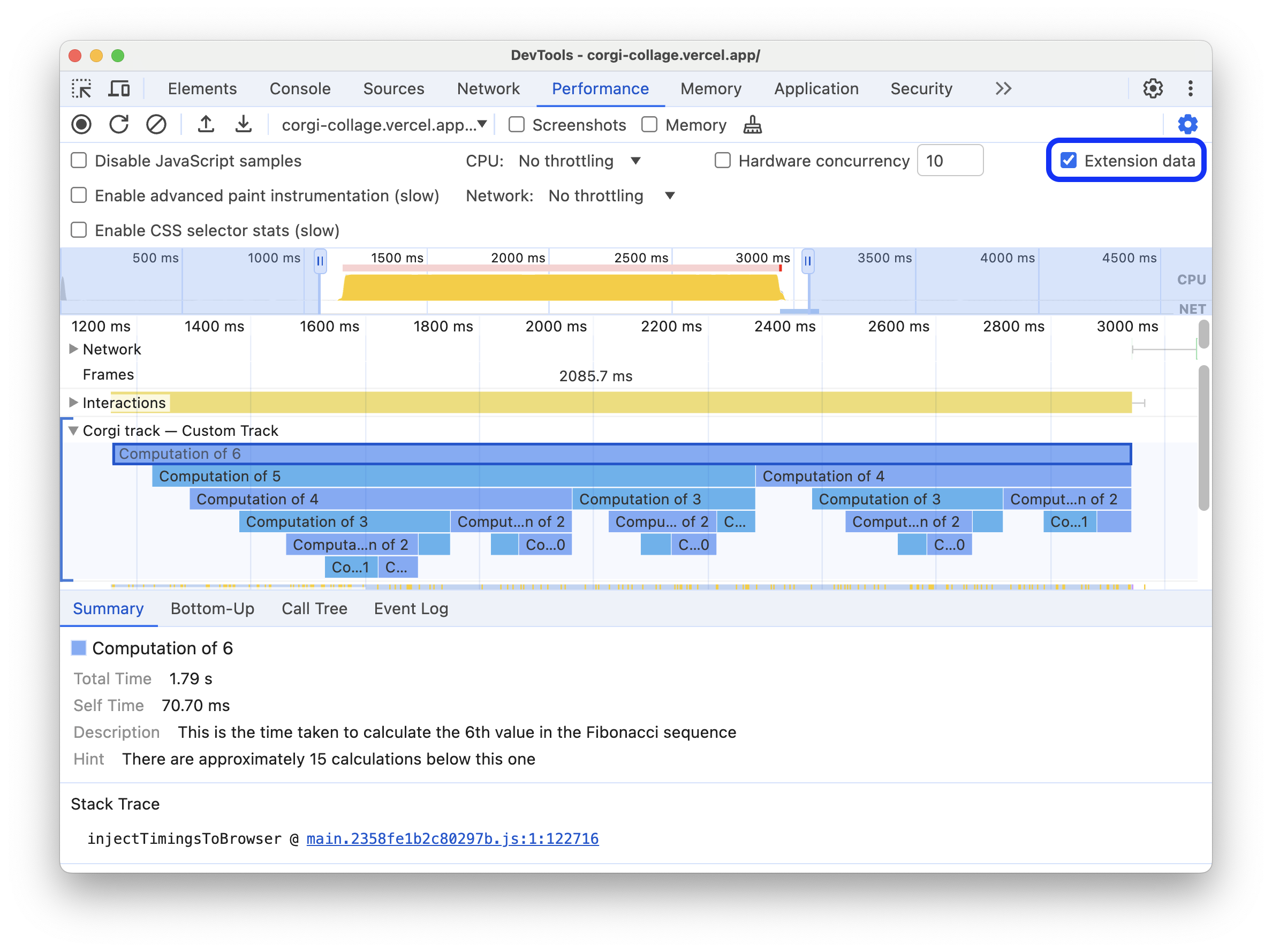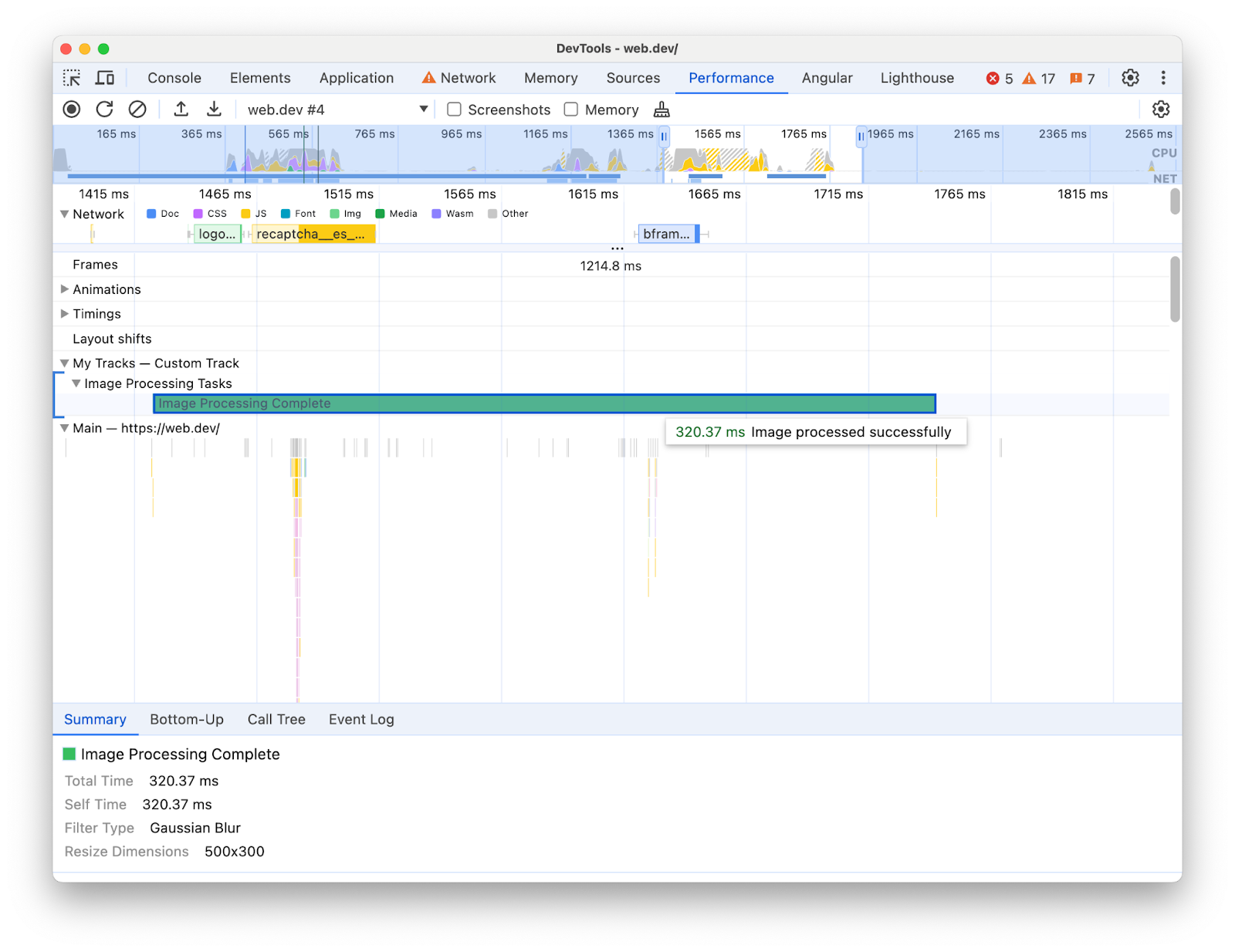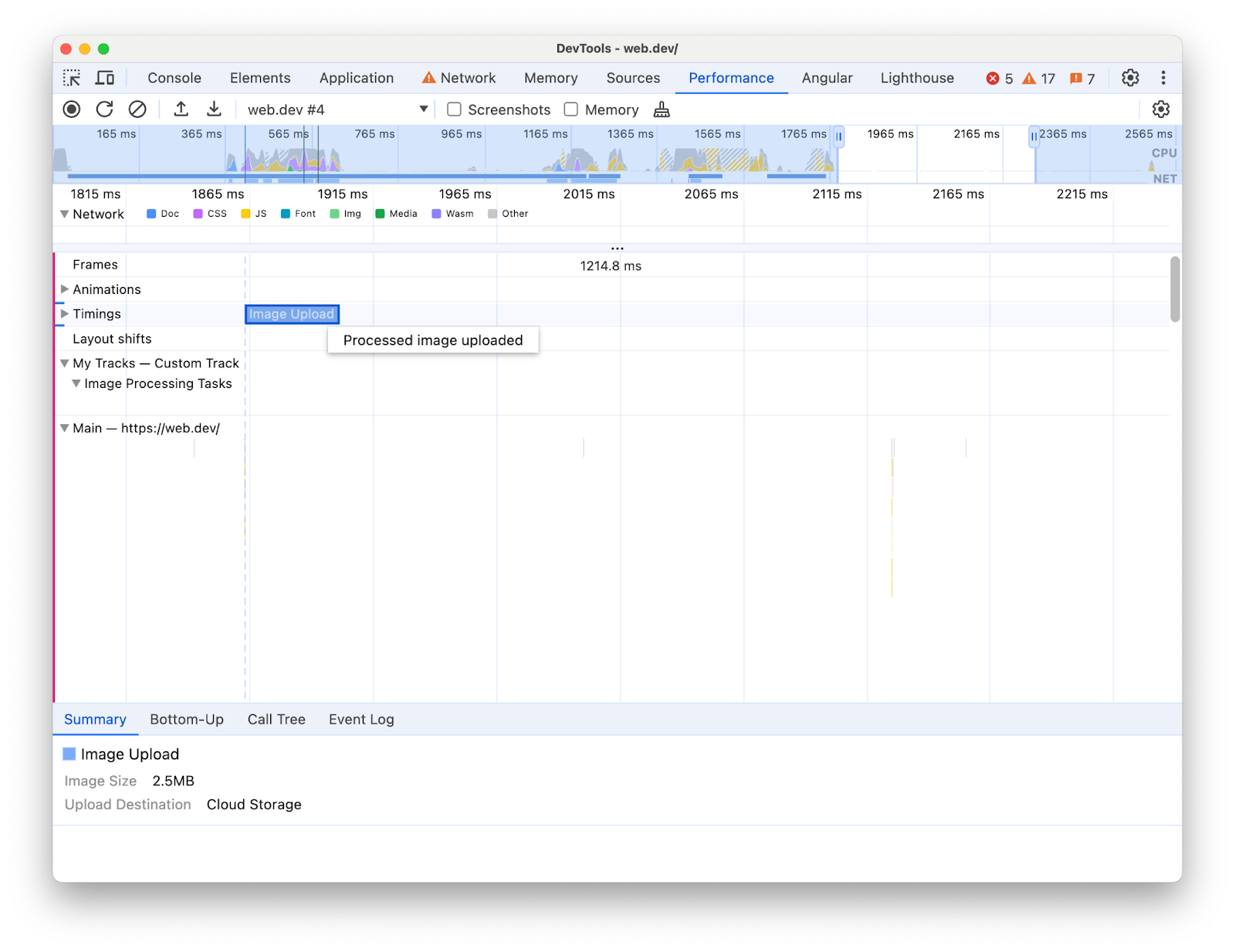Overview
The Performance panel supports the performance extensibility API, enabling the addition of custom data to the Performance timeline. This lets you inject your measurements and events directly into the performance timeline as a custom track or in the Timings track. This may be useful for developers of frameworks, libraries, and complex applications with custom instrumentation to gain a more comprehensive understanding of performance.
This API offers two distinct mechanisms:
1. The User Timings API (using performance.mark and performance.measure)
This API leverages the existing User Timings API. It also adds entries to the browser's internalperformance timeline, allowing for further analysis and integration with other performance tools.
2. The console.timeStamp API (extended for DevTools)
This API provides a high-performance method for instrumenting applications and surfacing timing data exclusively to the Performance panel in DevTools. It's designed for minimal runtime overhead, making it suitable for instrumenting hot paths and production builds. It does not add entries to the browser's internal performance timeline.
Key features
Both APIs offer:
- Custom Tracks: Add entries to custom tracks and track groups.
- Entries: Populate tracks with entries representing events or measurements.
- Color Customization: Color-code entries for visual differentiation.
Key Differences and when to use each API:
- User Timings API (
performance.mark,performance.measure):- Adds entries to both the Performance panel and the browser's internal performance timeline.
- Allows for rich data, including tooltips and detailed properties.
- Allows for adding markers: Highlight specific moments in the timeline with visual markers.
- Suitable for detailed performance analysis and when integration with other performance tools is required.
- Use when you need to store extra data with each entry, and when you are already using the User Timings API.
console.timeStampAPI:- Adds entries only to the Performance panel.
- Offers significantly higher performance, especially in production environments.
- Ideal for instrumenting hot paths and performance-critical code.
- No extra data such as tooltips or properties can be added.
- Use when performance overhead is a primary concern, and you need to quickly instrument code.
Inject your data with the User Timings API
To inject custom data, include a devtools object within the detail property of performance.mark and performance.measure methods. The structure of this devtools object determines how your data is displayed in the Performance panel.
Use
performance.markto record an instant event or timestamp in the timeline. You can mark the start or end of a specific operation or any point of interest that doesn't have a duration. When you include adevtoolsobject within thedetailproperty, the Performance panel shows a custom marker in the Timings track.Use
performance.measureto measure the duration of a task or process. When you include adevtoolsobject within thedetailproperty, the Performance panel shows custom measurement entries in the timeline in a custom track. If you're usingperformance.markas a reference point to create aperformance.measure, you don't need to include thedevtoolsobject inperformance.markcalls.
devtools object
These types define the structure of the devtools object for different extension features:
type DevToolsColor =
"primary" | "primary-light" | "primary-dark" |
"secondary" | "secondary-light" | "secondary-dark" |
"tertiary" | "tertiary-light" | "tertiary-dark" |
"error";
interface ExtensionTrackEntryPayload {
dataType?: "track-entry"; // Defaults to "track-entry"
color?: DevToolsColor; // Defaults to "primary"
track: string; // Required: Name of the custom track
trackGroup?: string; // Optional: Group for organizing tracks
properties?: [string, string][]; // Key-value pairs for detailed view
tooltipText?: string; // Short description for tooltip
}
interface ExtensionMarkerPayload {
dataType: "marker"; // Required: Identifies as a marker
color?: DevToolsColor; // Defaults to "primary"
properties?: [string, string][]; // Key-value pairs for detailed view
tooltipText?: string; // Short description for tooltip
}
Inject your data with console.timeStamp
The console.timeStamp API is extended to allow for the creation of custom timing entries in the Performance panel with minimal overhead.
console.timeStamp(label: string, start?: string, end?: string, trackName?: string, trackGroup?: string, color?: DevToolsColor);
label: The label for the timing entry.start: The name of a previously recorded timestamp (usingconsole.timeStamp(timeStampName)). If undefined, the current time is used.end: The name of a previously recorded timestamp. If undefined, the current time is used.trackName: The name of the custom track.trackGroup: The name of the track group.color: The color of the entry.
View your data in the timeline
To see your custom data in the timeline, in the Performance panel, turn on Capture settings > Extension data.

Try it on this demo page. Turn on Extension data, start a performance recording, click Add new Corgi on the demo page, then stop the recording. You'll see a custom track in the trace that contains events with custom tooltips and details in the Summary tab.
Code examples
Here are a few examples of how to use the API to add your own data to the Performance panel using each available mechanism.
User Timings API Examples:
In the next sections, see the examples of code that showcase how to add the following to the performance timeline:
Custom tracks and entries
Create custom tracks and populate them with entries to visualize your performance data in a custom track. For example:
// Mark used to represent the start of the image processing task
// The start time is defaulted to now
performance.mark("Image Processing Start");
// ... later in your code
// Track entry representing the completion of image processing
// with additional details and a tooltip
// The start time is a marker from earlier
// The end time is defaulted to now
performance.measure("Image Processing Complete", {
start: "Image Processing Start",
detail: {
devtools: {
dataType: "track-entry",
track: "Image Processing Tasks",
trackGroup: "My Tracks", // Group related tracks together
color: "tertiary-dark",
properties: [
["Filter Type", "Gaussian Blur"],
["Resize Dimensions", "500x300"]
],
tooltipText: "Image processed successfully"
}
}
});
This results in the following custom track entry in the performance timeline, along with its tooltip text and properties:

Markers
Visually highlight specific points of interest in the timeline with custom markers that span across all tracks. For example:
// Marker indicating when the processed image was uploaded
performance.mark("Image Upload", {
detail: {
devtools: {
dataType: "marker",
color: "secondary",
properties: [
["Image Size", "2.5MB"],
["Upload Destination", "Cloud Storage"]
],
tooltipText: "Processed image uploaded"
}
}
});
This results in the following marker in the Timings track, along with its tooltip text and properties:

console.timeStamp API Examples:
// Record a start timestamp
console.timeStamp("start");
// Measure duration from start to now
console.timeStamp("measure 1", "start", undefined, "My Track", "My Group", "primary-light");
// Record an end timestamp
console.timeStamp("end");
// Measure duration from start to end
console.timeStamp("measure 2", "start", "end", "My Track", "My Group", "secondary-dark");
This results in the following custom track entry in the performance timeline:



